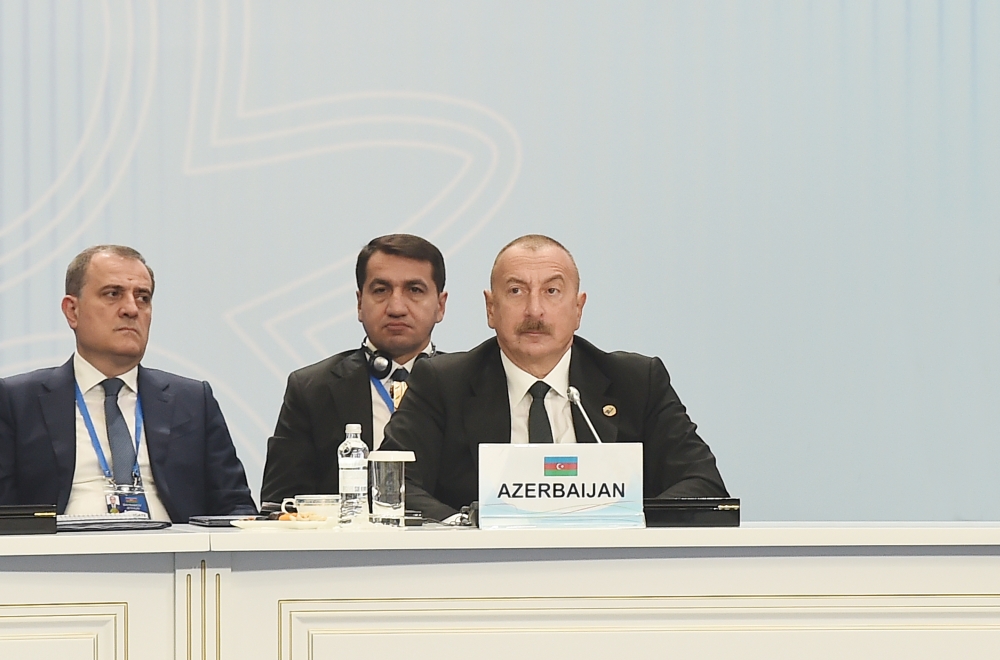President Ilham Aliyev has highlighted the ongoing landmine threat in the liberated lands of Azerbaijan and demanded information about the fate of missing persons and the locations of mass graves of Azerbaijanis as Armenia refuses to share it.
The president's addressed the issue at the 6th Summit of the Conference on Interaction and Confidence Building Measures in Asia (CICA), which took place in Kazakhstan’s capital Astana on Thursday.
President Aliyev said clearing those lands of landmines was not an easy task given the required timeframe and funds, and noted that Azerbaijan is one of the world’s most mine-contaminated countries.
“International experts estimate that Azerbaijan needs nearly 30 years and 25 billion US dollars to solve issues related to demining,” he said in his speech at the CICA summit.
According to President Aliyev, preliminary estimates revealed that Armenia laid more than one million mines on Azerbaijani territory during its occupation of those lands.
The Karabakh (Garabagh) and East Zangazur regions of Azerbaijan had been heavily mined since the 1990s. Armenia launched a full-blown military assault against Azerbaijan following the Soviet Union’s dissolution in 1991. The bloody war lasted until a ceasefire was reached in 1994, which resulted in Armenia occupying 20 percent of Azerbaijan’s internationally-recognized territories. Over 30,000 Azerbaijanis were killed and one million others were expelled from those lands in a brutal ethnic cleansing campaign carried out by Armenia.
On September 27, 2020, the decades-old conflict between the two countries reignited after Armenia’s forces deployed in occupied Azerbaijani lands shelled military positions and civilian settlements of Azerbaijan. During the counter-attack operations that lasted 44 days, Azerbaijani forces liberated over 300 settlements, including the cities of Jabrayil, Fuzuli, Zangilan, Gubadli, and Shusha, from the Armenian occupation. The war ended with the signing of a tripartite statement on November 10, 2020, by Armenia, Azerbaijan, and Russia, under which Armenia also returned the occupied Aghdam, Kalbajar, and Lachin districts to Azerbaijan.
Since the end of hostilities, the Azerbaijani government has been carrying out demining operations in the liberated territories to expedite the return of internally displaced people to their homes.
Despite extensive efforts, demining operations faced many challenges due to Armenia’s refusal to hand over maps of the landmines’ locations. More than 250 Azerbaijani residents have been killed or severely wounded in the mine blasts in the liberated lands post-2020 war.
Azerbaijan obtained minefield maps of the once-occupied Aghdam, Fuzuli and Zangilan districts from Armenia, which reportedly identify the coordinates of 189,000 anti-tank and anti-personnel mines. Armenia also provided the Azerbaijani side with mine maps of other liberated territories of Azerbaijan. In exchange for maps, Azerbaijan released dozens of Armenian saboteurs detained in Azerbaijani territory after the ceasefire. However, Azerbaijan’s President Ilham Aliyev said the accuracy of these maps did not exceed 25 percent.
Meanwhile, President Aliyev also spoke about the fates of Azerbaijanis who went missing during the First Karabakh War with Armenia in 1991-1994. He said Armenia committed systematic crimes against the civilian population and military personnel of Azerbaijan.
“Around 3,900 Azerbaijani citizens still remain missing since the First Karabakh War. Most of them have been tortured, killed, and buried in mass graves. This year we discovered mass graves in two liberated villages,” President Aliyev said, adding that Armenia must provide Azerbaijan with information about the fate of missing persons and the exact locations of mass graves.
“We have demanded this information for almost two years, but the Armenian Government refuses to share it with Azerbaijan,” he concluded.
The remains of at least 40 Azerbaijanis were found in two separate mass graves discovered in the Khojavand district in February and October of this year. Examinations confirmed them to be the servicemen that were captured, tortured, and killed by the Armenian troops.
Earlier, the remains of 12 civilians were found in the Kalbajar district, where the Armenian armed forces committed the Bashlibel mass murder in 1993. In addition, mass graves of the Azerbaijanis were found in the Dashalti village near Shusha city, and the Farrukh height in the Khojaly district.
According to data released by Azerbaijan’s State Commission on Prisoners of War, Hostages, and Missing Persons, 46 Azerbaijani servicemen went missing in the Pirlar village of the Khojaly district in the 1990s. At the same time, 11 Azerbaijani servicemen went missing in the Aliaghali village of the Aghdam district. The commission is convinced that the remains of Azerbaijani servicemen who went missing during the First Karabakh War can be found in those lands.







 President Aliyev emphasized the critical role of the North-South Transport Corridor in fostering transport cooperation between Azerbaijan and Russi...
President Aliyev emphasized the critical role of the North-South Transport Corridor in fostering transport cooperation between Azerbaijan and Russi...
 Russian Foreign Minister Sergei Lavrov has reasserted that Moscow has no intentions to stop the fighting in Ukraine, even if peace talks commence.
Russian Foreign Minister Sergei Lavrov has reasserted that Moscow has no intentions to stop the fighting in Ukraine, even if peace talks commence.
 Iran has refuted reports of alleged damage to Shimon Peres Negev Nuclear Research Centre located southeast of Dimona, Israel, during the recent air...
Iran has refuted reports of alleged damage to Shimon Peres Negev Nuclear Research Centre located southeast of Dimona, Israel, during the recent air...
 Iran and Pakistan have signed eight cooperation documents in various fields, and agreed to strengthen ties to fight terrorism in the region.
Iran and Pakistan have signed eight cooperation documents in various fields, and agreed to strengthen ties to fight terrorism in the region.



